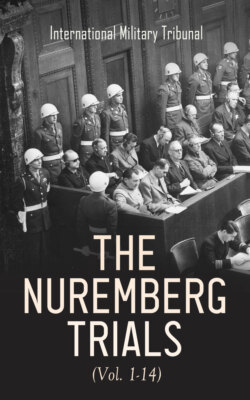Читать книгу The Nuremberg Trials (Vol. 1-14) - International Military Tribunal - Страница 130
The Nazi Regime in Germany
the Origin and Aims of the Nazi Party
ОглавлениеOn 5 January 1919, not two months after the conclusion of the Armistice which ended the first World War, and six months before the signing of the peace treaties at Versailles, there came into being in Germany a small political party called the German Labor Party. On 12 September 1919 Adolf Hitler became a member of this Party, and at the first public meeting held in Munich, on 24 February 1920, he announced the Party’s program. That program, which remained unaltered until the Party was dissolved in 1945, consisted of 25 points, of which the following five are of particular interest on account of the light they throw on the matters with which the Tribunal is concerned:
“Point 1. We demand the unification of all Germans in the Greater Germany, on the basis of the right of self-determination of peoples.
Point 2. We demand equality of rights for the German People in respect to the other nations; abrogation of the peace treaties of Versailles and Saint Germain.
Point 3. We demand land and territory for the sustenance of our people, and the colonization of our surplus population.
Point 4. Only a member of the race can be a citizen. A member of the race can only be one who is of German blood, without consideration of creed. Consequently no Jew can be a member of the race . . . .
Point 22. We demand abolition of the mercenary troops and formation of a national army.”
Of these aims, the one which seems to have been regarded as the most important, and which figured in almost every public speech, was the removal of the “disgrace” of the Armistice, and the restrictions of the peace treaties of Versailles and Saint Germain. In a typical speech at Munich on 13 April 1923, for example, Hitler said with regard to the Treaty of Versailles:
“The Treaty was made in order to bring 20 million Germans to their deaths, and to ruin the German Nation . . . . At its foundation our movement formulated three demands:
1. Setting aside of the Peace Treaty.
2. Unification of all Germans.
3. Land and soil to feed our Nation.”
The demand for the unification of all Germans in the Greater Germany was to play a large part in the events preceding the seizure of Austria and Czechoslovakia; the abrogation of the Treaty of Versailles was to become a decisive motive in attempting to justify the policy of the German Government; the demand for land was to be the justification for the acquisition of “living space” at the expense of other nations; the expulsion of the Jews from membership of the race of German blood was to lead to the atrocities against the Jewish people; and the demand for a national army was to result in measures of rearmament on the largest possible scale, and ultimately to war.
On 29 July 1921, the Party which had changed its name to National Sozialistische Deutsche Arbeiter Partei (NSDAP) was reorganized, Hitler becoming the first “Chairman”. It was in this year that the Sturmabteilung or SA was founded, with Hitler at its head, as a private para-military force, which allegedly was to be used for the purpose of protecting NSDAP leaders from attack by rival political parties, and preserving order at NSDAP meetings, but in reality was used for fighting political opponents on the streets. In March 1923 the Defendant Göring was appointed head of the SA.
The procedure within the Party was governed in the most absolute way by the “Leadership Principle” (Führerprinzip).
According to the principle, each Führer has the right to govern, administer, or decree, subject to no control of any kind and at his complete discretion, subject only to the orders he received from above.
This principle applied in the first instance to Hitler himself as the leader of the Party, and in a lesser degree to all other Party officials. All members of the Party swore an oath of “eternal allegiance” to the leader.
There were only two ways in which Germany could achieve the three main aims above-mentioned, by negotiation, or by force. The 25 points of the NSDAP program do not specifically mention the methods on which the leaders of the Party proposed to rely, but the history of the Nazi regime shows that Hitler and his followers were only prepared to negotiate on the terms that their demands were conceded, and that force would be used if they were not.
On the night of 8 November 1923, an abortive putsch took place in Munich. Hitler and some of his followers burst into a meeting in the Bürgerbräu Cellar, which was being addressed by the Bavarian Prime Minister Kahr, with the intention of obtaining from him a decision to march forthwith on Berlin. On the morning of 9 November, however, no Bavarian support was forthcoming, and Hitler’s demonstration was met by the armed forces of the Reichswehr and the police. Only a few volleys were fired; and after a dozen of his followers had been killed, Hitler fled for his life, and the demonstration was over. The Defendants Streicher, Frick, and Hess all took part in the attempted rising. Hitler was later tried for high treason, and was convicted and sentenced to imprisonment. The SA was outlawed. Hitler was released from prison in 1924 and in 1925 the Schutzstaffeln, or SS, was created, nominally to act as his personal bodyguard, but in reality to terrorize political opponents. This was also the year of the publication of Mein Kampf, containing the political views and aims of Hitler, which came to be regarded as the authentic source of Nazi doctrine.
